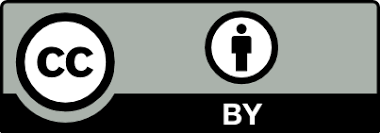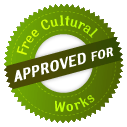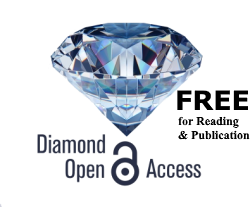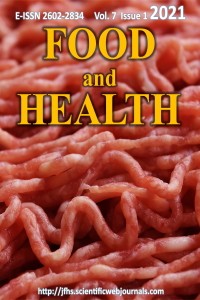Research Article
Abstract
References
- Akremi, N., Cappoen, D., Anthonissen, R., Bouraoui, A., Verschaeve, L. (2016). Evaluation of the genotoxicity and cytotoxicity of semipurified fractions from the Mediterranean brown algae, Dictyopteris membranacea. Pharmacognosy Magazine, 12(Suppl 4), S395. https://doi.org/10.4103/0973-1296.188318
- Al-Enazi, N.M., Awaad, A.S., Zain, M.E., Alqasoumi, S.I. (2018). Antimicrobial, antioxidant and anticancer activities of Laurencia catarinensis, Laurencia majuscula and Padina pavonica extracts. Saudi Pharmaceutical Journal, 26(1), 44-52. https://doi.org/10.1016/j.jsps.2017.11.001
- Atmaca, H., İlhan, S., Batır, B., Pulat, Ç. Ç., Güner, A., Bektaş, H. (2020). Novel benzimidazole derivatives: Synthesis, in vitro cytotoxicity, apoptosis and cell cycle studies. Chemico-Biological Interactions, 109163. https://doi.org/10.1016/j.cbi.2020.109163
- Bello, A., Padmanabhan, S., Thangamalai, R., Lakshmanan, K., Nagarajan, K. (2019). Evaluation of genotoxic effects of methanolic extract of brown seaweed Stoechospermum marginatum. The Journal of Phytopharmacology, 8(5), 226-231. https://doi.org/10.31254/phyto.2019.8504
- Cherry, P., O'Hara, C., Magee, P.J., McSorley, E.M., Allsopp, P.J. (2019). Risks and benefits of consuming edible seaweeds. Nutrition Reviews, 77(5), 307-329. https://doi.org/10.1093/nutrit/nuy066
- Das, B.C. (1988). Factors that influence formation of sister chromatid exchanges in human blood lymphocytes. CRC Critical Reviews in Toxicology, 19(1), 43-86. https://doi.org/10.3109/10408448809040817
- Evans, H.J., O’Riordan, M.L. (1975). Human peripheral blood lymphocytes for the analysis of chromosome aberrations in mutagen tests. Mutation Research, 31, 135-148. https://doi.org/10.1016/0165-1161(75)90082-5
- Field, C.B., Behrenfeld, M.J., Randerson, J.T., Falkowski, P. (1998). Primary production of the biosphere: integrating terrestrial and oceanic components. Science, 281, 237-240. https://doi.org/10.1126/science.281.5374.237
- Fenech, M. (1993). The cytokinesis-block micronucleus technique: a detailed description of the method and its application to genotoxicity studies in human populations. Mutation Research, 285, 35-44. https://doi.org/10.1016/0027-5107(93)90049-L
- Güner, A., Türkez, H., Aslan, A. (2012). The In Vitro Effects of Dermotocarpon Intestiniforme (A Lichen) Extracts Against Cadmium Induced Genetic and Oxidative Damage. Ekoloji. 21(84), 38-46. https://doi.org/10.5053/ekoloji.2012.845
- Güner, A., Köksal, Ç., Erel, Ş.B., Kayalar, H., Nalbantsoy, A., Sukatar, A., Karabay Yavaşoğlu, N.Ü. (2015). Antimicrobial and antioxidant activities with acute toxicity, cytotoxicity and mutagenicity of Cystoseira compressa (Esper) Gerloff & Nizamuddin from the coast of Urla (Izmir, Turkey). Cytotechnology, 67, 135-143. https://doi.org/10.1007/s10616-013-9668-x
- Güner, A., Karabay Yavasoğlu, N.U. (2018). Evaluation of antioxidant, antimicrobial and antimutagenic activity with irritation effects of Ceramium rubrum (Red Algae) extract. International Journal of Secondary Metabolite, 5, 279-287. https://doi.org/10.21448/ijsm.432654
- Güner, A., Nalbantsoy, A., Sukatar, A., Karabay Yavaşoğlu, N.Ü. (2019). Apoptosis-inducing activities of Halopteris scoparia L. Sauvageau (brown algae) on cancer cells and its biosafety and antioxidant properties. Cytotechnology, 71(3), 687-704. https://doi.org/10.1007/s10616-019-00314-5
- Güner, Ö., Güner, A., Yavaşoğlu, A., Karabay Yavaşoğlu, N.Ü., Kavlak, O. (2020). Ameliorative effect of edible Halopteris scoparia against cadmium-induced reproductive toxicity in male mice: A biochemical and histopathologic study. Andrologia, 52(6), e13591. https://doi.org/10.1111/and.13591
- Khaled, N., Hiba, M., Asma, C. (2012). Antioxidant and Antifungal Activities of Padina pavonica and Sargassum vulgare from the Lebanese Mediterranean Coast. Advances in Environmental Biology, 6, 42-48.
- Khanavi, M., Nabavi, M., Sadati, N., Shams Ardekani, M., Sohrabipour, J., Nabavi, S.M.B., Ghaeli P., Ostad, S.N. (2010). Cytotoxic activity of some marine brown algae against cancer cell lines. Biological Research, 43(1), 31-37. https://doi.org/10.4067/S0716-97602010000100005
- Kim, K.J., Lee, O.H., Lee, B.Y. (2010). Genotoxicity studies on fucoidan from Sporophyll of Undaria pinnatifida. Food and Chemical Toxicology, 48(4), 1101-1104. https://doi.org/10.1016/j.fct.2010.01.032
- Kusano, C., Ferrari, B. (2008). Total antioxidant capacity: a biomarker in biomedical and nutritional studies. Journal of Molecular Cell Biology, 7, 1-15.
- Mashjoor, S., Yousefzadi, M., Esmaeili, M.A., Rafiee, R. (2016). Cytotoxicity and antimicrobial activity of marine macroalgae (Dictyotaceae and Ulvaceae) from the Persian Gulf. Cytotechnology, 68(5), 1717-1726. https://doi.org/10.1007/s10616-015-9921-6
- McHugh, D.J. (2003). A guide to the seaweed industry. FAO Fish Tech Pap 441, Rome, Italy, p 105, ISBN 92-5-104958-0
- Migliore, L., Nieri, M., Amodio, S., Loprieno, N. (1989). The human lymphocyte micronucleus assay: a comparison between whole-blood and separated-lymphocyte cultures. Mutation Research Letters, 227(3), 167-172. https://doi.org/10.1016/0165-7992(89)90041-9
- Mohamed, S., Hashim, S.N., Rahman, H.A. (2012). Seaweeds: a sustainable functional food for complementary and alternative therapy. Trends in Food Science & Technology, 23, 83-96. https://doi.org/10.1016/j.tifs.2011.09.001
- Pereira, L. (2016). Edible seaweeds of the world. CRC Press, Boca Raton, p 52. ISBN: 13:978-1-4987-3050-1. https://doi.org/10.1201/b19970
- Roopashree, K.M., Naik, D. (2019). Advanced method of secondary metabolite extraction and quality analysis. Journal of Pharmacognosy and Phytochemistry, 8(3), 1829-1842.
- Song, M.Y., Ku, S.K., Han, J.S. (2012). Genotoxicity testing of low molecular weight fucoidan from brown seaweeds. Food and Chemical Toxicology, 50(3-4), 790-796. https://doi.org/10.1016/j.fct.2011.11.010
- Stanojkovic, T.P., Savikin, K., Zdunic, G., Kljajic, Z., Grozdanic, N., Antic, J. (2013). In Vitro Antitumoral Activities of Padina pavonica on Human Cervix and Breast Cancer Cell Lines. Journal of Medicinal Plants Research, 7, 419-424.
In vitro risk assessment of Padina pavonica (Linnaeus) (Brown algae)
Abstract
Padina pavonica (Linnaeus) Thivy 1960 is a brown algae that is antioxidant, antimicrobial, and anticancer effects and is generally used in soup, salad, and other dishes. However, no studies have been reported on safe consumption in humans to date. For this purpose, this study was conducted to determine the cytotoxic and genotoxic effects of P. pavonica on lymphocytes cultured from human blood. The water extract of P. pavonica was added into culture tubes at various concentrations (0.5-1000 μg/mL). Cytotoxic effects were determined by MTT assay. Antioxidant/oxidant status was evaluated by total antioxidant capacity (TAC) and total oxidative status (TOS) assays. Genotoxic effects were investigated by sister chromatid exchanges and micronucleus assays. Our results showed that P. pavonica had no genotoxic effects, even at higher concentrations. 1000 μg/mL concentration of P. pavonica caused an increase (P<0.05) TOS levels while significantly reducing cell viability. However, low concentrations (50 and 100 μg/mL) significantly increased (P<0.05) TAC levels. In conclusion, P. pavonica can be safely consumed with its non-genotoxic and antioxidant properties in a manner dose-dependent.
References
- Akremi, N., Cappoen, D., Anthonissen, R., Bouraoui, A., Verschaeve, L. (2016). Evaluation of the genotoxicity and cytotoxicity of semipurified fractions from the Mediterranean brown algae, Dictyopteris membranacea. Pharmacognosy Magazine, 12(Suppl 4), S395. https://doi.org/10.4103/0973-1296.188318
- Al-Enazi, N.M., Awaad, A.S., Zain, M.E., Alqasoumi, S.I. (2018). Antimicrobial, antioxidant and anticancer activities of Laurencia catarinensis, Laurencia majuscula and Padina pavonica extracts. Saudi Pharmaceutical Journal, 26(1), 44-52. https://doi.org/10.1016/j.jsps.2017.11.001
- Atmaca, H., İlhan, S., Batır, B., Pulat, Ç. Ç., Güner, A., Bektaş, H. (2020). Novel benzimidazole derivatives: Synthesis, in vitro cytotoxicity, apoptosis and cell cycle studies. Chemico-Biological Interactions, 109163. https://doi.org/10.1016/j.cbi.2020.109163
- Bello, A., Padmanabhan, S., Thangamalai, R., Lakshmanan, K., Nagarajan, K. (2019). Evaluation of genotoxic effects of methanolic extract of brown seaweed Stoechospermum marginatum. The Journal of Phytopharmacology, 8(5), 226-231. https://doi.org/10.31254/phyto.2019.8504
- Cherry, P., O'Hara, C., Magee, P.J., McSorley, E.M., Allsopp, P.J. (2019). Risks and benefits of consuming edible seaweeds. Nutrition Reviews, 77(5), 307-329. https://doi.org/10.1093/nutrit/nuy066
- Das, B.C. (1988). Factors that influence formation of sister chromatid exchanges in human blood lymphocytes. CRC Critical Reviews in Toxicology, 19(1), 43-86. https://doi.org/10.3109/10408448809040817
- Evans, H.J., O’Riordan, M.L. (1975). Human peripheral blood lymphocytes for the analysis of chromosome aberrations in mutagen tests. Mutation Research, 31, 135-148. https://doi.org/10.1016/0165-1161(75)90082-5
- Field, C.B., Behrenfeld, M.J., Randerson, J.T., Falkowski, P. (1998). Primary production of the biosphere: integrating terrestrial and oceanic components. Science, 281, 237-240. https://doi.org/10.1126/science.281.5374.237
- Fenech, M. (1993). The cytokinesis-block micronucleus technique: a detailed description of the method and its application to genotoxicity studies in human populations. Mutation Research, 285, 35-44. https://doi.org/10.1016/0027-5107(93)90049-L
- Güner, A., Türkez, H., Aslan, A. (2012). The In Vitro Effects of Dermotocarpon Intestiniforme (A Lichen) Extracts Against Cadmium Induced Genetic and Oxidative Damage. Ekoloji. 21(84), 38-46. https://doi.org/10.5053/ekoloji.2012.845
- Güner, A., Köksal, Ç., Erel, Ş.B., Kayalar, H., Nalbantsoy, A., Sukatar, A., Karabay Yavaşoğlu, N.Ü. (2015). Antimicrobial and antioxidant activities with acute toxicity, cytotoxicity and mutagenicity of Cystoseira compressa (Esper) Gerloff & Nizamuddin from the coast of Urla (Izmir, Turkey). Cytotechnology, 67, 135-143. https://doi.org/10.1007/s10616-013-9668-x
- Güner, A., Karabay Yavasoğlu, N.U. (2018). Evaluation of antioxidant, antimicrobial and antimutagenic activity with irritation effects of Ceramium rubrum (Red Algae) extract. International Journal of Secondary Metabolite, 5, 279-287. https://doi.org/10.21448/ijsm.432654
- Güner, A., Nalbantsoy, A., Sukatar, A., Karabay Yavaşoğlu, N.Ü. (2019). Apoptosis-inducing activities of Halopteris scoparia L. Sauvageau (brown algae) on cancer cells and its biosafety and antioxidant properties. Cytotechnology, 71(3), 687-704. https://doi.org/10.1007/s10616-019-00314-5
- Güner, Ö., Güner, A., Yavaşoğlu, A., Karabay Yavaşoğlu, N.Ü., Kavlak, O. (2020). Ameliorative effect of edible Halopteris scoparia against cadmium-induced reproductive toxicity in male mice: A biochemical and histopathologic study. Andrologia, 52(6), e13591. https://doi.org/10.1111/and.13591
- Khaled, N., Hiba, M., Asma, C. (2012). Antioxidant and Antifungal Activities of Padina pavonica and Sargassum vulgare from the Lebanese Mediterranean Coast. Advances in Environmental Biology, 6, 42-48.
- Khanavi, M., Nabavi, M., Sadati, N., Shams Ardekani, M., Sohrabipour, J., Nabavi, S.M.B., Ghaeli P., Ostad, S.N. (2010). Cytotoxic activity of some marine brown algae against cancer cell lines. Biological Research, 43(1), 31-37. https://doi.org/10.4067/S0716-97602010000100005
- Kim, K.J., Lee, O.H., Lee, B.Y. (2010). Genotoxicity studies on fucoidan from Sporophyll of Undaria pinnatifida. Food and Chemical Toxicology, 48(4), 1101-1104. https://doi.org/10.1016/j.fct.2010.01.032
- Kusano, C., Ferrari, B. (2008). Total antioxidant capacity: a biomarker in biomedical and nutritional studies. Journal of Molecular Cell Biology, 7, 1-15.
- Mashjoor, S., Yousefzadi, M., Esmaeili, M.A., Rafiee, R. (2016). Cytotoxicity and antimicrobial activity of marine macroalgae (Dictyotaceae and Ulvaceae) from the Persian Gulf. Cytotechnology, 68(5), 1717-1726. https://doi.org/10.1007/s10616-015-9921-6
- McHugh, D.J. (2003). A guide to the seaweed industry. FAO Fish Tech Pap 441, Rome, Italy, p 105, ISBN 92-5-104958-0
- Migliore, L., Nieri, M., Amodio, S., Loprieno, N. (1989). The human lymphocyte micronucleus assay: a comparison between whole-blood and separated-lymphocyte cultures. Mutation Research Letters, 227(3), 167-172. https://doi.org/10.1016/0165-7992(89)90041-9
- Mohamed, S., Hashim, S.N., Rahman, H.A. (2012). Seaweeds: a sustainable functional food for complementary and alternative therapy. Trends in Food Science & Technology, 23, 83-96. https://doi.org/10.1016/j.tifs.2011.09.001
- Pereira, L. (2016). Edible seaweeds of the world. CRC Press, Boca Raton, p 52. ISBN: 13:978-1-4987-3050-1. https://doi.org/10.1201/b19970
- Roopashree, K.M., Naik, D. (2019). Advanced method of secondary metabolite extraction and quality analysis. Journal of Pharmacognosy and Phytochemistry, 8(3), 1829-1842.
- Song, M.Y., Ku, S.K., Han, J.S. (2012). Genotoxicity testing of low molecular weight fucoidan from brown seaweeds. Food and Chemical Toxicology, 50(3-4), 790-796. https://doi.org/10.1016/j.fct.2011.11.010
- Stanojkovic, T.P., Savikin, K., Zdunic, G., Kljajic, Z., Grozdanic, N., Antic, J. (2013). In Vitro Antitumoral Activities of Padina pavonica on Human Cervix and Breast Cancer Cell Lines. Journal of Medicinal Plants Research, 7, 419-424.
There are 26 citations in total.
Details
| Primary Language | English |
|---|---|
| Subjects | Structural Biology |
| Journal Section | Research Articles |
| Authors | |
| Publication Date | November 9, 2020 |
| Submission Date | May 12, 2020 |
| Published in Issue | Year 2021 Volume: 7 Issue: 1 |
Journal is licensed under a
CreativeCommons Attribtion-ShareAlike 4.0 International Licence 


Diamond Open Access refers to a scholarly publication model in which journals and platforms do not charge fees to either authors or readers.
Open Access Statement:
This is an open access journal which means that all content is freely available without charge to the user or his/her institution. Users are allowed to read, download, copy, distribute, print, search, or link to the full texts of the articles, or use them for any other lawful purpose, without asking prior permission from the publisher or the author. This is in accordance with the BOAI definition of open access.
Archiving Policy:
Archiving is done according to ULAKBİM "DergiPark" publication policy (LOCKSS).

